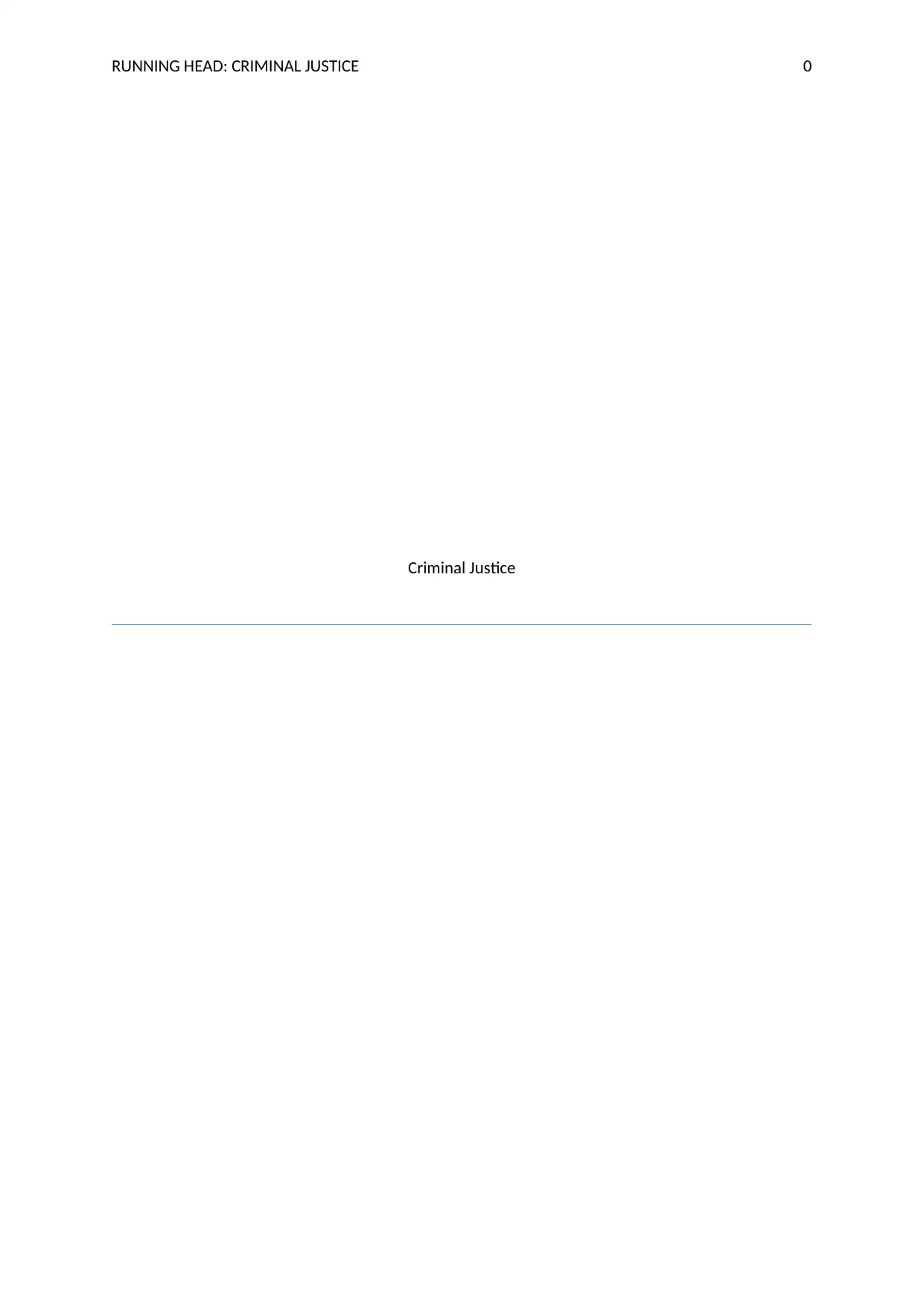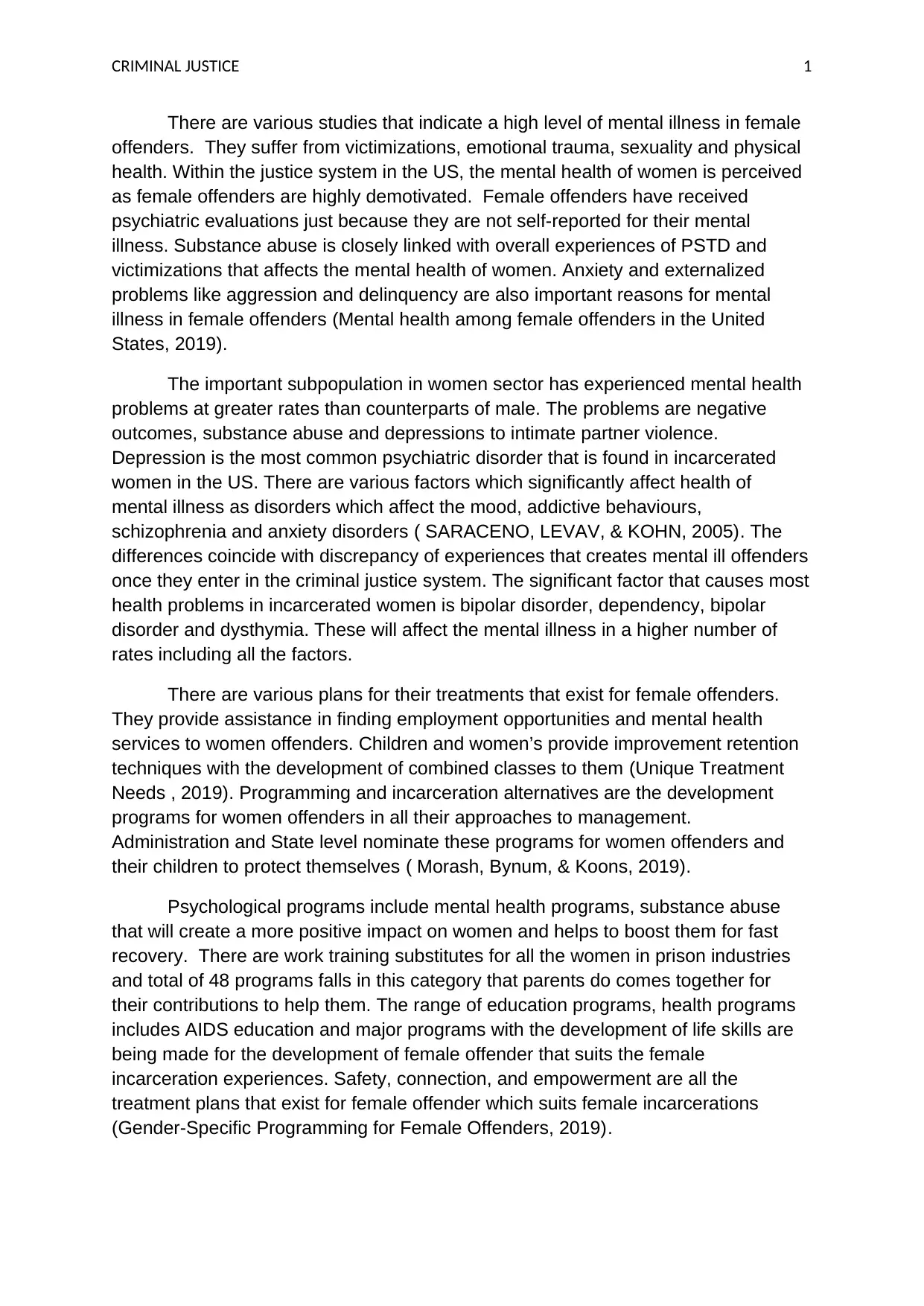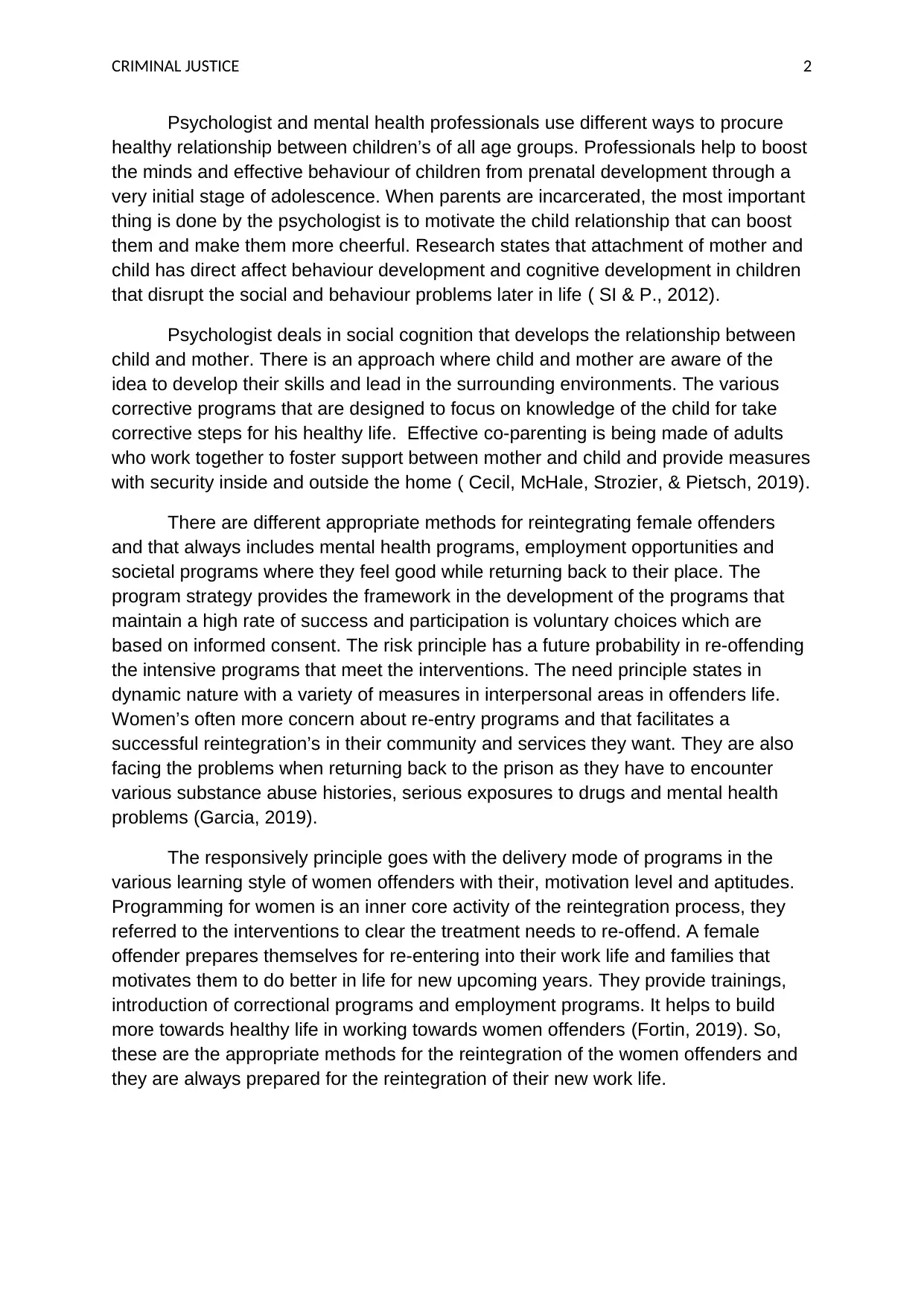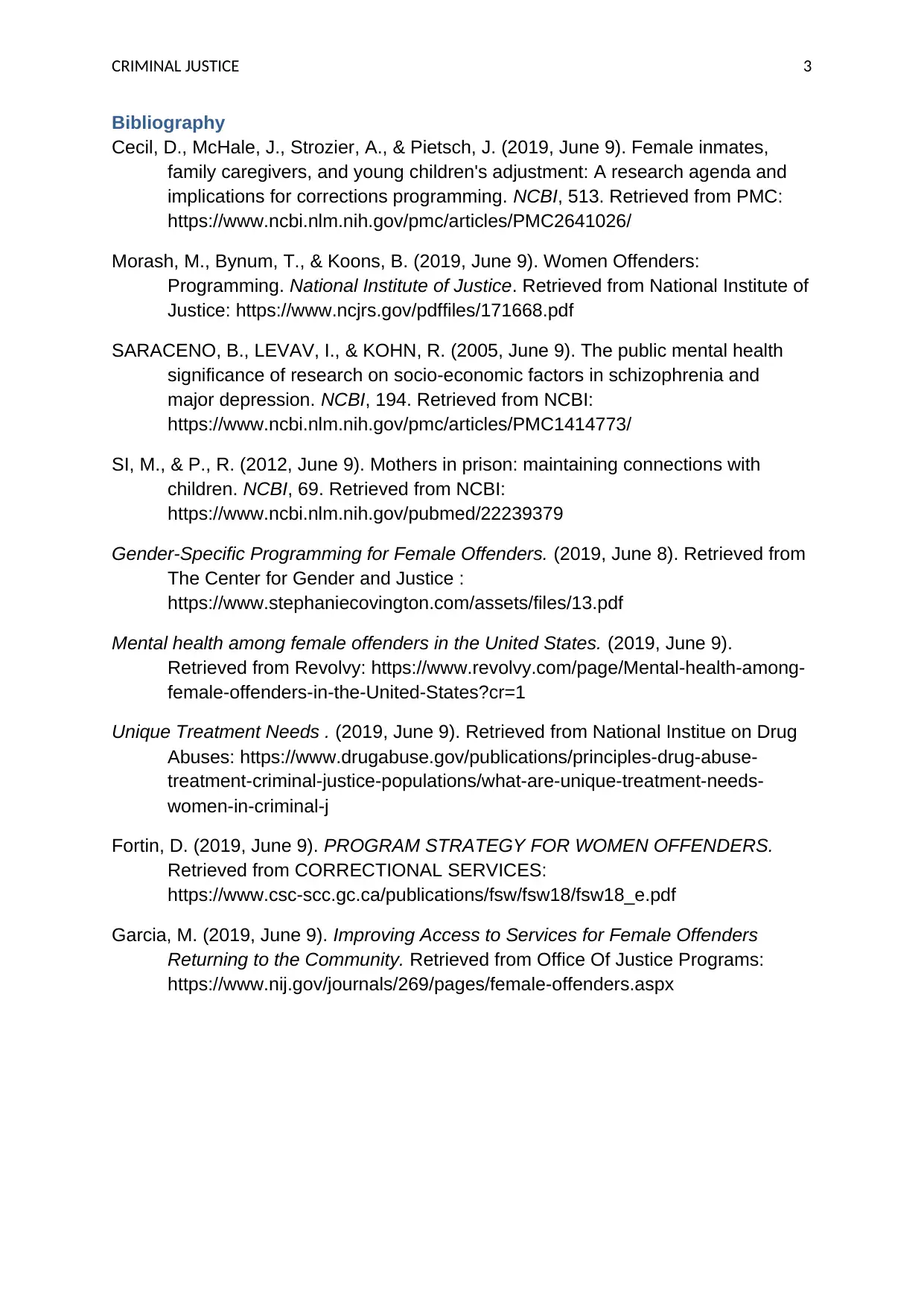Criminal Justice System and Mental Health of Female Offenders Analysis
VerifiedAdded on 2022/12/27
|4
|1317
|47
Report
AI Summary
This report delves into the critical issue of mental health among female offenders within the criminal justice system. It highlights the high prevalence of mental illnesses, often linked to experiences of victimization, emotional trauma, and substance abuse. The report explores the challenges female offenders face, including limited access to mental health services and the impact of incarceration on their well-being. It discusses the importance of gender-specific programming, psychological interventions, and the role of family support in the rehabilitation process. The report also examines the reintegration process, including the need for employment opportunities, societal programs, and mental health services to facilitate successful re-entry into the community. Furthermore, the report emphasizes the significance of tailored treatment plans, such as those focused on safety, connection, and empowerment, to address the unique needs of female offenders. This report also covers the programs that exist to help female offenders, including those that offer assistance in finding employment and mental health services. Overall, the report provides an analysis of the mental health issues and treatment strategies for female offenders in the criminal justice system.

RUNNING HEAD: CRIMINAL JUSTICE 0
Criminal Justice
Criminal Justice
Paraphrase This Document
Need a fresh take? Get an instant paraphrase of this document with our AI Paraphraser

CRIMINAL JUSTICE 1
There are various studies that indicate a high level of mental illness in female
offenders. They suffer from victimizations, emotional trauma, sexuality and physical
health. Within the justice system in the US, the mental health of women is perceived
as female offenders are highly demotivated. Female offenders have received
psychiatric evaluations just because they are not self-reported for their mental
illness. Substance abuse is closely linked with overall experiences of PSTD and
victimizations that affects the mental health of women. Anxiety and externalized
problems like aggression and delinquency are also important reasons for mental
illness in female offenders (Mental health among female offenders in the United
States, 2019).
The important subpopulation in women sector has experienced mental health
problems at greater rates than counterparts of male. The problems are negative
outcomes, substance abuse and depressions to intimate partner violence.
Depression is the most common psychiatric disorder that is found in incarcerated
women in the US. There are various factors which significantly affect health of
mental illness as disorders which affect the mood, addictive behaviours,
schizophrenia and anxiety disorders ( SARACENO, LEVAV, & KOHN, 2005). The
differences coincide with discrepancy of experiences that creates mental ill offenders
once they enter in the criminal justice system. The significant factor that causes most
health problems in incarcerated women is bipolar disorder, dependency, bipolar
disorder and dysthymia. These will affect the mental illness in a higher number of
rates including all the factors.
There are various plans for their treatments that exist for female offenders.
They provide assistance in finding employment opportunities and mental health
services to women offenders. Children and women’s provide improvement retention
techniques with the development of combined classes to them (Unique Treatment
Needs , 2019). Programming and incarceration alternatives are the development
programs for women offenders in all their approaches to management.
Administration and State level nominate these programs for women offenders and
their children to protect themselves ( Morash, Bynum, & Koons, 2019).
Psychological programs include mental health programs, substance abuse
that will create a more positive impact on women and helps to boost them for fast
recovery. There are work training substitutes for all the women in prison industries
and total of 48 programs falls in this category that parents do comes together for
their contributions to help them. The range of education programs, health programs
includes AIDS education and major programs with the development of life skills are
being made for the development of female offender that suits the female
incarceration experiences. Safety, connection, and empowerment are all the
treatment plans that exist for female offender which suits female incarcerations
(Gender-Specific Programming for Female Offenders, 2019).
There are various studies that indicate a high level of mental illness in female
offenders. They suffer from victimizations, emotional trauma, sexuality and physical
health. Within the justice system in the US, the mental health of women is perceived
as female offenders are highly demotivated. Female offenders have received
psychiatric evaluations just because they are not self-reported for their mental
illness. Substance abuse is closely linked with overall experiences of PSTD and
victimizations that affects the mental health of women. Anxiety and externalized
problems like aggression and delinquency are also important reasons for mental
illness in female offenders (Mental health among female offenders in the United
States, 2019).
The important subpopulation in women sector has experienced mental health
problems at greater rates than counterparts of male. The problems are negative
outcomes, substance abuse and depressions to intimate partner violence.
Depression is the most common psychiatric disorder that is found in incarcerated
women in the US. There are various factors which significantly affect health of
mental illness as disorders which affect the mood, addictive behaviours,
schizophrenia and anxiety disorders ( SARACENO, LEVAV, & KOHN, 2005). The
differences coincide with discrepancy of experiences that creates mental ill offenders
once they enter in the criminal justice system. The significant factor that causes most
health problems in incarcerated women is bipolar disorder, dependency, bipolar
disorder and dysthymia. These will affect the mental illness in a higher number of
rates including all the factors.
There are various plans for their treatments that exist for female offenders.
They provide assistance in finding employment opportunities and mental health
services to women offenders. Children and women’s provide improvement retention
techniques with the development of combined classes to them (Unique Treatment
Needs , 2019). Programming and incarceration alternatives are the development
programs for women offenders in all their approaches to management.
Administration and State level nominate these programs for women offenders and
their children to protect themselves ( Morash, Bynum, & Koons, 2019).
Psychological programs include mental health programs, substance abuse
that will create a more positive impact on women and helps to boost them for fast
recovery. There are work training substitutes for all the women in prison industries
and total of 48 programs falls in this category that parents do comes together for
their contributions to help them. The range of education programs, health programs
includes AIDS education and major programs with the development of life skills are
being made for the development of female offender that suits the female
incarceration experiences. Safety, connection, and empowerment are all the
treatment plans that exist for female offender which suits female incarcerations
(Gender-Specific Programming for Female Offenders, 2019).

CRIMINAL JUSTICE 2
Psychologist and mental health professionals use different ways to procure
healthy relationship between children’s of all age groups. Professionals help to boost
the minds and effective behaviour of children from prenatal development through a
very initial stage of adolescence. When parents are incarcerated, the most important
thing is done by the psychologist is to motivate the child relationship that can boost
them and make them more cheerful. Research states that attachment of mother and
child has direct affect behaviour development and cognitive development in children
that disrupt the social and behaviour problems later in life ( SI & P., 2012).
Psychologist deals in social cognition that develops the relationship between
child and mother. There is an approach where child and mother are aware of the
idea to develop their skills and lead in the surrounding environments. The various
corrective programs that are designed to focus on knowledge of the child for take
corrective steps for his healthy life. Effective co-parenting is being made of adults
who work together to foster support between mother and child and provide measures
with security inside and outside the home ( Cecil, McHale, Strozier, & Pietsch, 2019).
There are different appropriate methods for reintegrating female offenders
and that always includes mental health programs, employment opportunities and
societal programs where they feel good while returning back to their place. The
program strategy provides the framework in the development of the programs that
maintain a high rate of success and participation is voluntary choices which are
based on informed consent. The risk principle has a future probability in re-offending
the intensive programs that meet the interventions. The need principle states in
dynamic nature with a variety of measures in interpersonal areas in offenders life.
Women’s often more concern about re-entry programs and that facilitates a
successful reintegration’s in their community and services they want. They are also
facing the problems when returning back to the prison as they have to encounter
various substance abuse histories, serious exposures to drugs and mental health
problems (Garcia, 2019).
The responsively principle goes with the delivery mode of programs in the
various learning style of women offenders with their, motivation level and aptitudes.
Programming for women is an inner core activity of the reintegration process, they
referred to the interventions to clear the treatment needs to re-offend. A female
offender prepares themselves for re-entering into their work life and families that
motivates them to do better in life for new upcoming years. They provide trainings,
introduction of correctional programs and employment programs. It helps to build
more towards healthy life in working towards women offenders (Fortin, 2019). So,
these are the appropriate methods for the reintegration of the women offenders and
they are always prepared for the reintegration of their new work life.
Psychologist and mental health professionals use different ways to procure
healthy relationship between children’s of all age groups. Professionals help to boost
the minds and effective behaviour of children from prenatal development through a
very initial stage of adolescence. When parents are incarcerated, the most important
thing is done by the psychologist is to motivate the child relationship that can boost
them and make them more cheerful. Research states that attachment of mother and
child has direct affect behaviour development and cognitive development in children
that disrupt the social and behaviour problems later in life ( SI & P., 2012).
Psychologist deals in social cognition that develops the relationship between
child and mother. There is an approach where child and mother are aware of the
idea to develop their skills and lead in the surrounding environments. The various
corrective programs that are designed to focus on knowledge of the child for take
corrective steps for his healthy life. Effective co-parenting is being made of adults
who work together to foster support between mother and child and provide measures
with security inside and outside the home ( Cecil, McHale, Strozier, & Pietsch, 2019).
There are different appropriate methods for reintegrating female offenders
and that always includes mental health programs, employment opportunities and
societal programs where they feel good while returning back to their place. The
program strategy provides the framework in the development of the programs that
maintain a high rate of success and participation is voluntary choices which are
based on informed consent. The risk principle has a future probability in re-offending
the intensive programs that meet the interventions. The need principle states in
dynamic nature with a variety of measures in interpersonal areas in offenders life.
Women’s often more concern about re-entry programs and that facilitates a
successful reintegration’s in their community and services they want. They are also
facing the problems when returning back to the prison as they have to encounter
various substance abuse histories, serious exposures to drugs and mental health
problems (Garcia, 2019).
The responsively principle goes with the delivery mode of programs in the
various learning style of women offenders with their, motivation level and aptitudes.
Programming for women is an inner core activity of the reintegration process, they
referred to the interventions to clear the treatment needs to re-offend. A female
offender prepares themselves for re-entering into their work life and families that
motivates them to do better in life for new upcoming years. They provide trainings,
introduction of correctional programs and employment programs. It helps to build
more towards healthy life in working towards women offenders (Fortin, 2019). So,
these are the appropriate methods for the reintegration of the women offenders and
they are always prepared for the reintegration of their new work life.
⊘ This is a preview!⊘
Do you want full access?
Subscribe today to unlock all pages.

Trusted by 1+ million students worldwide

CRIMINAL JUSTICE 3
Bibliography
Cecil, D., McHale, J., Strozier, A., & Pietsch, J. (2019, June 9). Female inmates,
family caregivers, and young children's adjustment: A research agenda and
implications for corrections programming. NCBI, 513. Retrieved from PMC:
https://www.ncbi.nlm.nih.gov/pmc/articles/PMC2641026/
Morash, M., Bynum, T., & Koons, B. (2019, June 9). Women Offenders:
Programming. National Institute of Justice. Retrieved from National Institute of
Justice: https://www.ncjrs.gov/pdffiles/171668.pdf
SARACENO, B., LEVAV, I., & KOHN, R. (2005, June 9). The public mental health
significance of research on socio-economic factors in schizophrenia and
major depression. NCBI, 194. Retrieved from NCBI:
https://www.ncbi.nlm.nih.gov/pmc/articles/PMC1414773/
SI, M., & P., R. (2012, June 9). Mothers in prison: maintaining connections with
children. NCBI, 69. Retrieved from NCBI:
https://www.ncbi.nlm.nih.gov/pubmed/22239379
Gender-Specific Programming for Female Offenders. (2019, June 8). Retrieved from
The Center for Gender and Justice :
https://www.stephaniecovington.com/assets/files/13.pdf
Mental health among female offenders in the United States. (2019, June 9).
Retrieved from Revolvy: https://www.revolvy.com/page/Mental-health-among-
female-offenders-in-the-United-States?cr=1
Unique Treatment Needs . (2019, June 9). Retrieved from National Institue on Drug
Abuses: https://www.drugabuse.gov/publications/principles-drug-abuse-
treatment-criminal-justice-populations/what-are-unique-treatment-needs-
women-in-criminal-j
Fortin, D. (2019, June 9). PROGRAM STRATEGY FOR WOMEN OFFENDERS.
Retrieved from CORRECTIONAL SERVICES:
https://www.csc-scc.gc.ca/publications/fsw/fsw18/fsw18_e.pdf
Garcia, M. (2019, June 9). Improving Access to Services for Female Offenders
Returning to the Community. Retrieved from Office Of Justice Programs:
https://www.nij.gov/journals/269/pages/female-offenders.aspx
Bibliography
Cecil, D., McHale, J., Strozier, A., & Pietsch, J. (2019, June 9). Female inmates,
family caregivers, and young children's adjustment: A research agenda and
implications for corrections programming. NCBI, 513. Retrieved from PMC:
https://www.ncbi.nlm.nih.gov/pmc/articles/PMC2641026/
Morash, M., Bynum, T., & Koons, B. (2019, June 9). Women Offenders:
Programming. National Institute of Justice. Retrieved from National Institute of
Justice: https://www.ncjrs.gov/pdffiles/171668.pdf
SARACENO, B., LEVAV, I., & KOHN, R. (2005, June 9). The public mental health
significance of research on socio-economic factors in schizophrenia and
major depression. NCBI, 194. Retrieved from NCBI:
https://www.ncbi.nlm.nih.gov/pmc/articles/PMC1414773/
SI, M., & P., R. (2012, June 9). Mothers in prison: maintaining connections with
children. NCBI, 69. Retrieved from NCBI:
https://www.ncbi.nlm.nih.gov/pubmed/22239379
Gender-Specific Programming for Female Offenders. (2019, June 8). Retrieved from
The Center for Gender and Justice :
https://www.stephaniecovington.com/assets/files/13.pdf
Mental health among female offenders in the United States. (2019, June 9).
Retrieved from Revolvy: https://www.revolvy.com/page/Mental-health-among-
female-offenders-in-the-United-States?cr=1
Unique Treatment Needs . (2019, June 9). Retrieved from National Institue on Drug
Abuses: https://www.drugabuse.gov/publications/principles-drug-abuse-
treatment-criminal-justice-populations/what-are-unique-treatment-needs-
women-in-criminal-j
Fortin, D. (2019, June 9). PROGRAM STRATEGY FOR WOMEN OFFENDERS.
Retrieved from CORRECTIONAL SERVICES:
https://www.csc-scc.gc.ca/publications/fsw/fsw18/fsw18_e.pdf
Garcia, M. (2019, June 9). Improving Access to Services for Female Offenders
Returning to the Community. Retrieved from Office Of Justice Programs:
https://www.nij.gov/journals/269/pages/female-offenders.aspx
1 out of 4
Related Documents
Your All-in-One AI-Powered Toolkit for Academic Success.
+13062052269
info@desklib.com
Available 24*7 on WhatsApp / Email
![[object Object]](/_next/static/media/star-bottom.7253800d.svg)
Unlock your academic potential
Copyright © 2020–2025 A2Z Services. All Rights Reserved. Developed and managed by ZUCOL.





